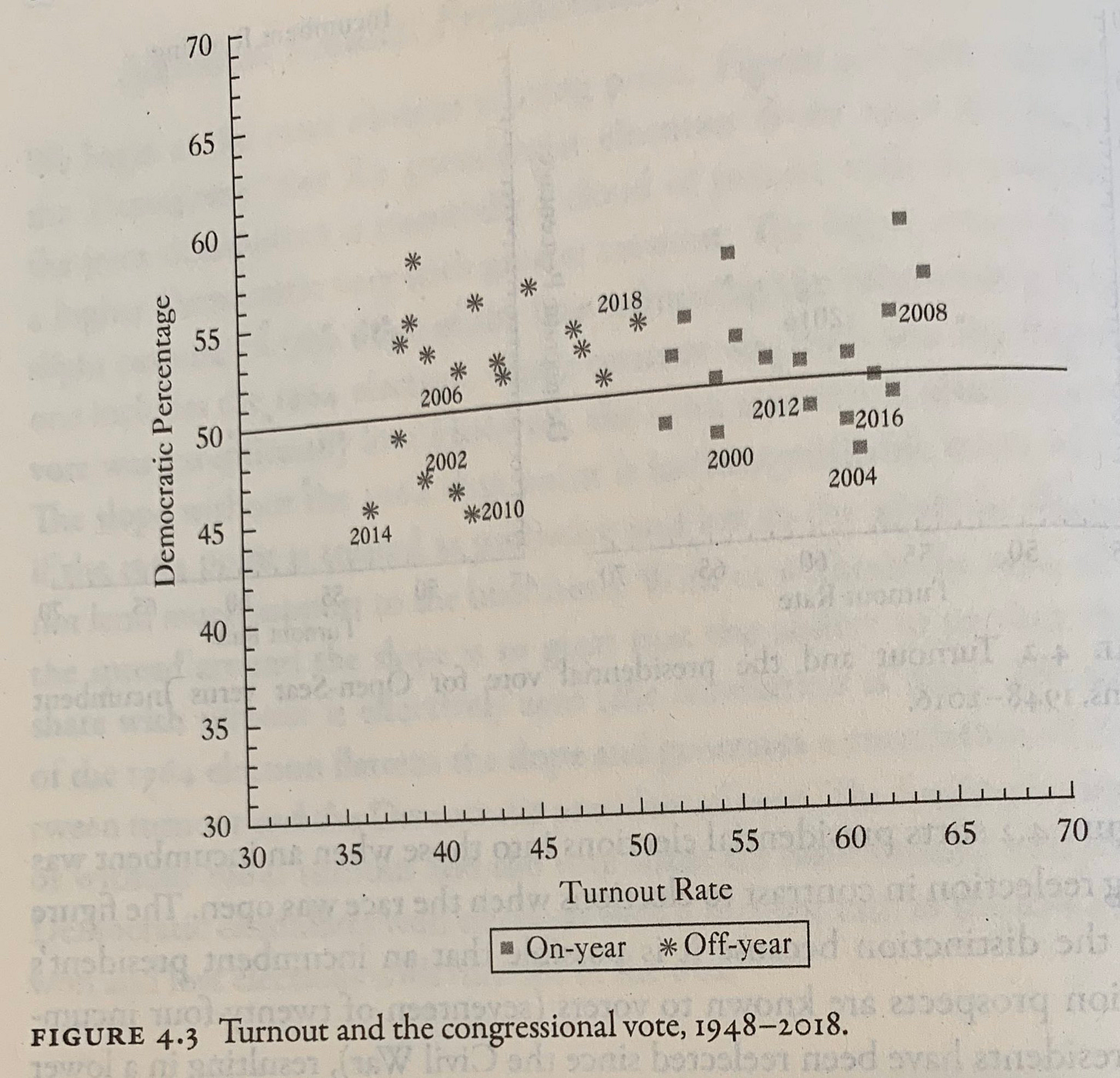How do we know that higher turnout benefits Democrats?
Preliminary thoughts on a new book that claims it doesn’t
On Twitter this week Matt Grossman linked to a new book called “The Turnout Myth” in which the authors political scientists Daron Shaw (a former professor of mine) and John Petrocik suggest that the usual claim that higher turnout benefits Democrats is wrong. Grossman tweeted out the following graph as a central finding of the book. In congressional elections with higher turnout, it shows, Democrats have not tended to out-perform other elections with lower turnout.

Case closed? I’m not entirely convinced, and actually have a few pretty severe issues with this analysis. (Note that I have yet to read the book, so this criticism does come with slight ignorance attached. The authors may very well address these criticisms. I’ll address them again after I’ve read it. But my hope is that this just gets out analytic juices flowing.)
First, I think that basing the claim on the historical relationship between Democratic vote and turnout nationally might be conflating too many other variables. There are lots of factors separate from turnout that may impact Democratic vote share, and vice-versa. At the very least, we want some method of controlling for these other factors. Perhaps year fixed-effects? Maybe Democratic vote share controlling for electoral fundamentals? Something like that.
Second, I think we get into particular trouble if we ignore that the relationships between turnout and voting and demographics have changed over time. In the 1950s, for example, non-voters may have indeed looked very demographically similar to voters. Their attitudes would have been similar, too—so counterfactual elections with higher turnout may not have then shown bigger increases in Democratic vote intention.
But the demographic correlates of voting behavior have changed a lot since 1950! And my research into the 2016 and 2018 elections show that the demographic correlates of non-voting today are also linked to a higher probability of voting for Democrats. Higher turnout in counterfactual elections today would likely benefit Democrats, even if that’s not true historically. The longer view obscures this fact.
To be sure, Shaw and Petrocik also theorize that the opposition party might benefit from better mobilization in higher turnout counterfactuals. This would jibe with what we’ve discussed so far; in 2016 and 2018, under their theory, we would expect that non-voters would be more inclined to vote for Democrats than the actual voting population. But I’m not convinced by this. Though they have long predicted turnout, age and education also became major cutting lines for voting in the early 2000s, and certainly lasted through Obama’s presidency. Even in 2012 we would have likely expected non-voters to be more Democratic. Their theory doesn’t really account for this.
Thinking through this problem has inspired me to do some more long-term analyses of the dynamics between demographics, turnout, and voting. I think we also want to consider the role that the Electoral College plays in presidential elections when discussing turnout; we know today that higher turnout would swing the national popular vote toward Democrats in a major way, but might actually improve the Republicans’ geographic advantage in converting raw votes to Electoral College votes.
But for now, my takeaway is that Shaw and Petrocik’s “The Turnout Myth” benefits greatly from its situation in the historical context, which might allow it to ignore some very real and recent changes in American politics that could actually prove them wrong.
Editor’s note:
Thanks for reading my thoughts on this subject. And thanks for subscribing! Your membership adds up and makes all this newslettering possible (reminder: I do all this work independently). Please consider sharing online or with a friend; the more readers, the merrier!
As always, send me your tips about what you’d like to read about next, or your feedback otherwise. You can reach me via email at elliott@thecrosstab.com or @gelliottmorris on Twitter.
—Elliott




I wonder if this isn't based in some part on mobilization efforts. A good GOTV effort can increase turnout quite substantially, and I think that Dems are far more likely to run campaigns of this kind (proposition one is sustained by many studies, I'm not sure about 2)
Thanks for this article. This has been a question of mine.
Aslo are you familar with a poll aggregator for live caller, education weighted polls?
If not is there a list of polls that are live caller and weighted by education?